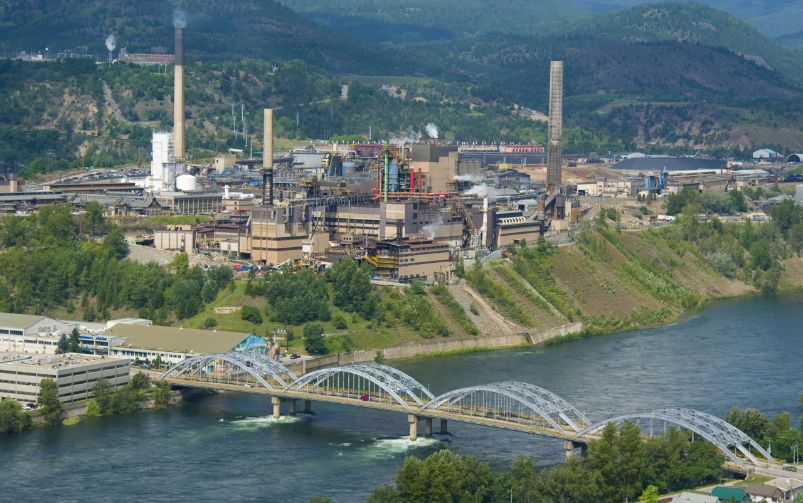The electrowinning unit in pH7’s Vancouver facility extracts the metal from the solution and produces metal on site. Courtesy of pH7 Technologies
A growing demand for copper worldwide is fuelling companies like pH7 Technologies to find ways to extract copper and other critical minerals from low-grade ore, tailings and mine waste.
The Vancouver-based company is currently developing a process that uses heap leaching to recover copper from sulfide ores, like chalcopyrite, whereas traditional heap leaching is usually confined to oxide ores. Mohammad Doostmohammadi, the company’s CEO and founder, who has a master’s degree in chemical engineering and has worked as a mining engineer, said in an interview with CIM Magazine that sulfide ores, which are low-grade and expensive to extract, represent 80 per cent of copper deposits worldwide.
The company has found a way to extract copper from sulfide ores by using a proprietary electrochemical unit that can be inserted into a mining company’s existing heap leaching operation, without any changes to its flowsheet.
Through this electrochemical reaction, Doostmohammadi explained that the sulfide ore is oxidized and then dissolved into a solution. The solution goes through a solvent extraction unit, and then an electrowinning unit, where the metal is extracted, before the process starts over again in a closed-loop format.
Innovate BC and the National Research Council of Canada Industrial Research Assistance Program announced on Feb. 4 that they awarded $149,000 to the company as part of the BC Fast Pilot program, which was launched in 2019 and helps small and medium-sized businesses in the province to design, build and operate a pilot of their technology in real-world conditions. A total of $1.5 million has been awarded to 12 pilot demonstrations in B.C. as part of this funding round.
“The funding is helping us to scale [our technology] up from a lab scale to a pilot scale,” said Doostmohammadi. “We can test it on a pilot scale and that’s going to be the first step prior to designing our commercial plants for mining operations.”
For phase one of the pilot, the company is conducting testing at its facility in Vancouver. Phase two of the pilot is slated to begin next year and will consist of testing the technology on site at a copper mine, preferably in Canada, but the company is also looking at potential sites in South America.
In between phase one and phase two, the company is simulating its heap-leaching process by performing column testing on ore samples from mines around the world. It noted in a Feb. 4 Innovate BC press release that it is conducting its pilot in partnership with an undisclosed B.C.-based mining company to evaluate the technology’s mineral recovery and environmental benefits.
Doostmohammadi spoke to the sustainability of closed-loop heap leaching operations: “The main consumable throughout this process is electricity, it’s not the chemicals. The chemicals, the reagents are changing phases and organically bonding with the metals. At the end of the process, they regenerate through electrochemical processes and can be reused.”
He added that the company’s heap leaching process could also help mining operations expand their revenue streams and production as the copper can be extracted as a copper cathode at the end of the process. The company’s process focuses on copper due to the sizable market for the mineral. Doostmohammadi said the technology can also be applied to gold, silver, nickel and cobalt.
Pilot testing of the technology started at the end of 2024 and is expected to run until March 2026. Doostmohammadi said the company will likely continue running the pilot after that to continue gathering data. He added that the results from the pilot have so far exceeded the lab-scale results.
“We achieved more than 80 per cent recovery for copper from chalcopyrite, which is very impressive. We are seeing better [results] than what we achieved in the lab, not only [on the] recovery, but also the unit economy as well as the amount of electricity that we are consuming,” he said.
The funding will also help the company tackle one of the biggest challenges it has encountered so far: finding the right talent to work on its heap leaching technology. Doostmohammadi noted that the market for mining, metallurgical and mineral processing engineers and technicians is tight.
“[The funding] not only brings money, it brings credit, as well as a connection network, and we can hire talent that can help us to implement this technology into the mining side,” he said.
The company is currently looking for more samples of ores from mining companies to see how its heap leaching technology could work with different mineralogies and mining operations. “We would love to see more Canadian mines trusting this technology and sending us samples,” Doostmohammadi said.




